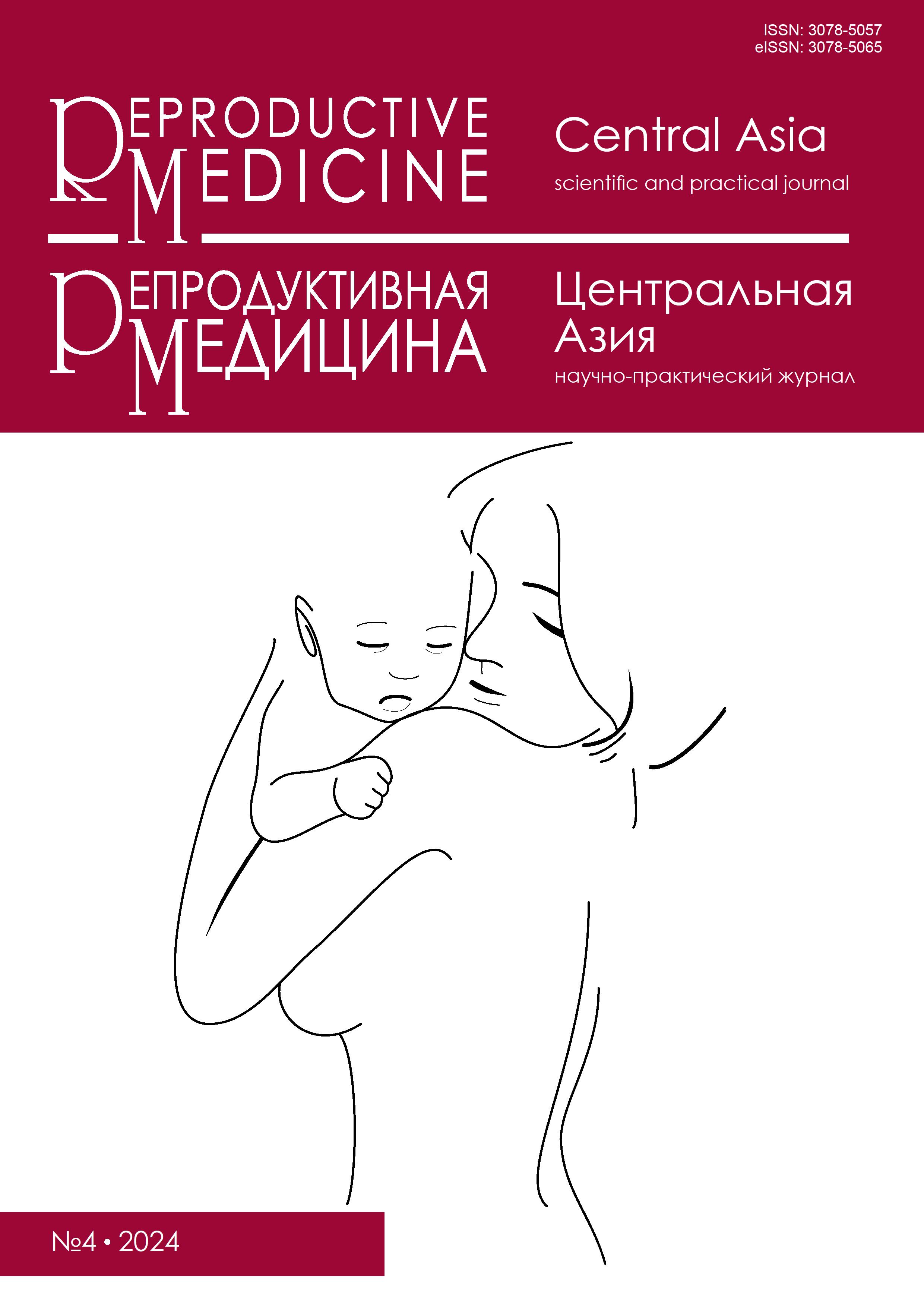Comparative characteristics of obstetric/neonatal outcomes and histologic findings in the placenta during in vitro fertilization for normal endometrial extracellular matrix remodeling and incomplete secretory transformation
DOI:
https://doi.org/10.37800/RM.4.2024.414Keywords:
obstetric/neonatal outcomes, endometrial biopsy, placenta, in vitro fertilization, endometrial extracellular matrix, secretory transformationAbstract
Relevance: Reproductive losses are complex conditions that affect a large number of the population, increase the risk of various adverse obstetric and perinatal outcomes, and raise many questions regarding causes and treatment options. Some couples experience repeated failures after the transfer of good-quality embryos without any obvious cause, and this becomes a serious ongoing problem after IVF procedures. It can be assumed that in these couples, endometrial insufficiency may be a possible cause of implantation failure, so endometrial morphological examination remains relevant.
The study aimed to compare the clinical and morphological characteristics of the mother-placenta-fetus system during in vitro fertilization depending on the histochemical pattern of endometrial extracellular matrix remodeling.
Materials and Methods: The study groups included 109 cases of pregnancy after IVF in women with normal remodeling of the ECM of the mid-secretory endometrium and 118 pregnancies after IVF in women with incomplete secretory remodeling of the ECM of the endometrium. Endometrial biopsies were obtained on day 21 of the menstrual cycle from the fundus and upper part of the anterior and posterior uterine wall. All cases were reviewed by two pathologists who had no information on the pregnancy outcome and clinical data. Statistical analysis was performed using SPSS.
Results: Clinical and biochemical pregnancy losses were more frequent in the incomplete secretory remodeling of the endometrial extracellular matrix compared to the group with normal endometrial remodeling (p<0.05), and newborns in the group with incomplete secretory remodeling of the endometrial extracellular matrix were characterized by lower weight. Placentas with incomplete secretory remodeling of the endometrial extracellular matrix were more often damaged by chronic hypoxic injuries of the MVM type and more often characterized by maturation disorders of the AVM type compared to the group with normal remodeling of the extracellular matrix (p<0,05).
Conclusion: These results indicate reproductive losses and chronic hypoxic placental injuries with incomplete secretory remodeling of the extracellular matrix of the endometrium, which shows the need for further studies to stratify groups at risk of reproductive losses.
References
Fee N, McEvoy A, Cullen S, Doyle S, Crosby D, Allen C. Pregnancy outcomes following recurrent miscarriage. Ir J Med Sci. 2023;192(5):2255-2258.
https://doi.org/10.1007/s11845-023-03305-w
Vomstein K, Aulitzky A, Strobel L, Bohlmann M, Feil K, Rudnik-Schöneborn S, Zschocke J, Toth B. Recurrent Spontaneous Miscarriage: a Comparison of International Guidelines. GeburtshilfeFrauenheilkd. 2021;81(7):769-779.
https://doi.org/10.1055/a-1380-3657
Dugas C, Slane VH. Miscarriage (Archived). In: StatPearls [Internet]. Treasure Island (FL): StatPearls Publishing; 2022 Jun 27 [updated 2024 Jan–]. PMID: 30422585. https://pubmed.ncbi.nlm.nih.gov/30422585/
Kanmaz AG, İnan AH, Beyan E, Budak A. The effects of threatened abortions on pregnancy outcomes. Ginekol Pol. 2019;90(4):195-200.
https://doi.org/10.5603/GP.a2019.0035
Wu CQ, Nichols K, Carwana M, Cormier N, Maratta C. Preterm birth after recurrent pregnancy loss: a systematic review and meta-analysis. Fertil Steril. 2022;117(4):811-819. https://doi.org/10.1016/j.fertnstert.2022.01.004
Ошахтиева Н., Камышанский Е., Чернова Л., Амирбекова Ж. Неполноценное секреторное ремоделирование экстрацеллюлярного матрикса эндометрия ассоциируется с рецидивирующими репродуктивными потерями. Репродуктивная медицина (Центральная Азия). 2023;4:49-59.
Oshakhtiyeva N, Kamyshanskiy Е, Chernova L, Amirbekova Zh. 2023. Incomplete secretory remodeling of the extracellular matrix of the endometrium is associated with recrudescent reproductive losses. Reproductive Medicine (Central Asia). 2023;4: 49-59. (In Russ.).
https://doi.org/10.37800/RM.4.2023.43-51
Linehan LA, San Lazaro Campillo I, Hennessy M, Flannery C, O’Donoghue K. Reproductive outcomes following recurrent first-trimester miscarriage: a retrospective cohort study. Hum Reprod Open. 2022;2022(4):hoac045. https://doi.org/10.1093/hropen/hoac045
Matsumoto H. Molecular and cellular events during blastocyst implantation in the receptive uterus: clues from mouse models. J Reprod Dev. 2017;63(5):445-454. https://doi.org/10.1262/jrd.2017-047
Evans J, Rai A, Nguyen HPT, Poh QH, Elglass K, Simpson RJ, Salamonsen LA, Greening DW. Human Endometrial Extracellular Vesicles Functionally Prepare Human Trophectoderm Model for Implantation: Understanding Bidirectional Maternal-Embryo Communication. Proteomics. 2019;19(23):e1800423. https://doi.org/10.1002/pmic.201800423
Berger M, Patel H, Buyalos R, Hubert G, Wang C, Shamonki M, Quinn M. Estradiol to progesterone ratio is not a predictor of oocyte maturity at time of ovulation trigger. J Assist Reprod Genet. 2022;39(7):1667-1672.
https://doi.org/10.1007/s10815-022-02491-3
Harvey AJ, Willson BE, Surrey ES, Gardner DK. Ovarian stimulation protocols: impact on oocyte and endometrial quality and function. Fertil Steril. 2024;27:S0015-0282(24)01973-3. https://doi.org/10.1016/j.fertnstert.2024.08.340
Glujovsky D, Pesce R, Fiszbajn G, Sueldo C, Hart RJ, Ciapponi A. Endometrial preparation for women undergoing embryo transfer with frozen embryos or embryos derived from donor oocytes. Cochrane Database Syst Rev. 2010;1:CD006359. https://doi.org/10.1002/14651858.CD006359.pub2 Upd.: Cochrane Database Syst Rev. 2020;10:CD006359.
https://doi.org/10.1002/14651858.CD006359.pub3
Ou Z, Du J, Liu N, Li J, Lin X. Effects of reduced follicle-stimulating hormone dosage before human chorionic gonadotropin trigger on in vitro fertilization outcomes. BMC Pregnancy Childbirth. 2023;23(1):612.
https://doi.org/10.1186/s12884-023-05943-5
Palomba S, Vitagliano A, Marci R, Caserta D. Endometrial Scratching for Improving Endometrial Receptivity: a Critical Review of Old and New Clinical Evidence. Reprod Sci. 2023;30(6):1701-1711.
https://doi.org/10.1007/s43032-022-01125-4
Vitagliano A, Vitale SG, Cianci A, Ferrero S, Barra F, Andrisani A, Ambrosini G. Endometrial scratching for infertility: The never-ending story. J Gynecol Obstet Hum Reprod. 2020;49(6):101743.
https://doi.org/10.1016/j.jogoh.2020.101743
Mei Y, Wang Y, Ke X, Liang X, Lin Y, Wang F. Does endometrial receptivity array improve reproductive outcomes in euploid embryo transfer cycles? A systematic review. Front Endocrinol (Lausanne). 2023;14:1251699. https://doi.org/10.3389/fendo.2023.1251699
Hromadová L, Tokareva I, Veselá K, Trávník P, Veselý J. Endometrial Receptivity Analysis - a tool to increase an implantation rate in assisted reproduction. Ceska Gynekol. 2019;84(3):177-183.
https://pubmed.ncbi.nlm.nih.gov/31324106/
Lucas ES, Dyer NP, Murakami K, Lee YH, Chan YW, Grimaldi G, Muter J, Brighton PJ, Moore JD, Patel G, Chan JK, Takeda S, Lam EW, Quenby S, Ott S, Brosens JJ. Loss of Endometrial Plasticity in Recurrent Pregnancy Loss. Stem Cells. 2016;34(2):346-356.
https://doi.org/10.1002/stem.2222
Sharma M, Dubey P, Sunda U, Tilva H. A Comprehensive Review of the Endometrial Receptivity Array in Euploid Embryo Transfer Cycles. Cureus. 2024;16(6):e63173. https://doi.org/10.7759/cureus.63173
Giacomini E, Scotti GM, Vanni VS, Lazarevic D, Makieva S, Privitera L, Signorelli S, Cantone L, Bollati V, Murdica V, Tonon G, Papaleo E, Candiani M, Viganò P. Global transcriptomic changes occur in uterine fluid-derived extracellular vesicles during the endometrial window for embryo implantation. Hum Reprod. 2021;36(8):2249-2274. https://doi.org/10.1093/humrep/deab123
Sui C, Liao Z, Bai J, Hu D, Yue J, Yang S. Current knowledge on the role of extracellular vesicles in endometrial receptivity. Eur J Med Res. 2023;28(1):471. https://doi.org/10.1186/s40001-023-01459-y
Reticulum Stain Kit (Modified Gomori’s) For the Histological Visualization of Reticular Fibers. Ver 1. Last upd. 27 June 2018. Doc. No. ab236473.
Khong TY, Mooney EE, Ariel I, Balmus NC, Boyd TK, Brundler MA, Derricott H, Evans MJ, Faye-Petersen OM, Gillan JE, Heazell AE, Heller DS, Jacques SM, Keating S, Kelehan P, Maes A, McKay EM, Morgan TK, Nikkels PG, Parks WT, Redline RW, Scheimberg I, Schoots MH, Sebire NJ, Timmer A, Turowski G, van der Voorn JP, van Lijnschoten I, Gordijn SJ. Sampling and definitions of placental lesions: Amsterdam placental Workshop group consensus statement. Arch Pathol Lab Med. 2016;140:698-713.
https://doi.org/10.5858/arpa.2015-0225-CC
Zegers-Hochschild F, Adamson GD, Dyer S, Racowsky C, de Mouzon J, Sokol R, Rienzi L, Sunde A, Schmidt L, Cooke ID, Simpson JL, van der Poel S. The International Glossary on Infertility and Fertility Care, 2017. Hum Reprod. 2017 Sep 1;32(9):1786-1801. https://doi.org/10.1093/humrep/dex234
Wang Y, CaiS, Chen X, Sun Q, Yin T, Diao L. The role of extracellular vesicles from placenta and endometrium in pregnancy: Insights from tumor biology. J Reprod Immunol. 2024;162:104210.
https://doi.org/10.1016/j.jri.2024.104210
Gestational Hypertension and Preeclampsia: ACOG Practice Bulletin, Number 222. Obstet Gynecol. 2020 Jun;135(6):e237-e260.
https://doi.org/10.1097/AOG.0000000000003891
American Diabetes Association. 2. Classification and Diagnosis of Diabetes: Standards of Medical Care in Diabetes-2021. Diabetes Care. 2021;44(Suppl 1):S15-S33. https://doi.org/10.2337/dc21-S002. Erratum in: Diabetes Care. 2021;44(9):2182. https://doi.org/10.2337/dc21-ad09
Wallace K, Harris S, Addison A, Bean C. HELLP Syndrome: Pathophysiology and Current Therapies. Curr Pharm Biotechnol. 2018;19(10):816-826. https://doi.org/10.2174/1389201019666180712115215
American College of Obstetricians and Gynecologists Committee on Practice Bulletins-Obstetrics and the Society for Maternal-Fetal Medicine. ACOG practice bulletin no. 204: fetal growth restriction. Obstet Gynecol. 2019;133:e97-109.
https://doi.org/10.1097/AOG.0000000000003070
Beal JR, Ma Q, Bagchi IC, Bagchi MK. Role of Endometrial Extracellular Vesicles in Mediating Cell-to-Cell Communication in the Uterus: A Review. Cells. 2023 Nov 7;12(22):2584.
https://doi.org/10.3390/cells12222584
Gibb D, Sabaratnam A. Fetal Monitoring in Practice. E-Book. London: Elsevier Health Sciences; 2016. eBook ISBN: 9780702046810. https://pubmed.ncbi.nlm.nih.gov/37998319/
https://shop.elsevier.com/books/fetal-monitoring-in-practice/gibb/978-0-7020-4348-2
Nakamura K, Kusama K, Suda Y, Fujiwara H, Hori M, Imakawa K. Emerging Role of Extracellular Vesicles in Embryo-Maternal Communication throughout Implantation Processes. Int J Mol Sci. 2020 Aug 1;21(15):5523. doi: 10.3390/ijms21155523. PMID: 32752293; PMCID: PMC7432060. https://pubmed.ncbi.nlm.nih.gov/32752293/
Redline RW, Ravishankar S, Bagby CM, Saab ST, Zarei S. Four major patterns of placental injury: a stepwise guide for understanding and implementing the 2016 Amsterdam consensus. Mod Pathol. 2021;34:1074-1092. https://pubmed.ncbi.nlm.nih.gov/33558658/
Ernst LM. Maternal vascular malperfusion of the placental bed. APMIS. 2018;126(7):551-560. https://doi.org/10.1111/apm.12833
Salafia CM, Rukat C, Dygulska B, Miller RK, Misra DP. Placental chronic inflammatory histopathology and fetal growth in a cohort with universal placental examination. Placenta. 2024;154:193-200.
https://doi.org/10.1016/j.placenta.2024.06.020 Redline RW, Ravishankar S. Fetal vascular malperfusion, an update. APMIS. 2018;126(7):561-569.
https://doi.org/10.1111/apm.12849
Cornish EF, McDonnell T, Williams DJ. Chronic Inflammatory Placental Disorders Associated With Recurrent Adverse Pregnancy Outcome. Front Immunol. 2022;13:825075. https://doi.org/10.3389/fimmu.2022.825075
Redline RW. Classification of placental lesions. Am J Obstet Gynecol. 2015;213(4 Suppl):S21-28. https://doi.org/10.1016/j.ajog.2015.05.056
Guo Z, Xu X, Zhang L, Zhang L, Yan L, Ma J. Endometrial thickness is associated with incidence of small-for-gestational-age infants in fresh in vitro fertilization-intracytoplasmic sperm injection and embryo transfer cycles. Fertil Steril. 2020;113(4):745-752. https://doi.org/10.1016/j.fertnstert.2019.12.014
Sebastian T, Ravikumar G, Crasta J. Villitis of unknown etiology (VUE): effect on placental size and association with clinical parameters. J Matern Fetal Neonatal Med. 2022;35(9):1695-1702.
https://doi.org/10.1080/14767058.2020.1767577
Ravikumar G, Liza V. Clinical and Histological Associations of Chronic Inflammatory Lesions in Preterm Placentas: Uncovering the Hidden Dangers. Pediatr Dev Pathol. 2024;27(1):59-66.
https://doi.org/10.1177/10935266231194161
Ganer Herman H, Volodarsky-Perel A, Ton Nu TN, Machado-Gedeon A, Cui Y, Shaul J, Dahan MH. Pregnancy complications and placental histology following embryo transfer with a thinner endometrium. Hum Reprod. 2022;37(8):1739-1745. https://doi.org/10.1093/humrep/deac148
Sacha CR, Harris AL, James K, Basnet K, Freret TS, Yeh J, Kaimal A, Souter I, Roberts DJ. Placental pathology in live births conceived with in vitro fertilization after fresh and frozen embryo transfer. Am J Obstet Gynecol. 2020;222(4):360.e1-360.e16. https://doi.org/10.1016/j.ajog.2019.09.047
Huang J, Lin J, Lu X, Gao H, Song N, Cai R, Kuang Y. Association between endometrial thickness and neonatal outcomes in intrauterine insemination cycles: a retrospective analysis of 1,016 live-born singletons. Reprod Biol Endocrinol. 2020 May 14;18(1):48. doi: 10.1186/s12958-020-00597-w. PMID: 32410619; PMCID: PMC7222451. https://pubmed.ncbi.nlm.nih.gov/32410619/
Ribeiro VC, Santos-Ribeiro S, De Munck N, Drakopoulos P, Polyzos NP, Schutyser V, Verheyen G, Tournaye H, Blockeel C. Should we continue to measure endometrial thickness in modern-day medicine? The effect on live birth rates and birth weight. Reprod Biomed Online. 2018 Apr;36(4):416-426. https://doi.org/10.1016/j.rbmo.2017.12.016
Zhang J, Liu H, Mao X, Chen Q, Si J, Fan Y, Xiao Y, Wang Y, Kuang Y. Effect of endometrial thickness on birthweight in frozen embryo transfer cycles: an analysis including 6181 singleton newborns. Hum Reprod. 2019;34(9):1707-1715. https://doi.org/10.1093/humrep/dez103
Downloads
Published
How to Cite
Issue
Section
License
Copyright (c) 2024 The rights to a manuscript accepted for publication are transferred to the Journal Publisher. When reprinting all or part of the material, the author must refer to the primary publication in this journal.

This work is licensed under a Creative Commons Attribution-NonCommercial-NoDerivatives 4.0 International License.
The articles published in this Journal are licensed under the CC BY-NC-ND 4.0 (Creative Commons Attribution – Non-Commercial – No Derivatives 4.0 International) license, which provides for their non-commercial use only. Under this license, users have the right to copy and distribute the material in copyright but are not permitted to modify or use it for commercial purposes. Full details on the licensing are available at https://creativecommons.org/licenses/by-nc-nd/4.0/.





